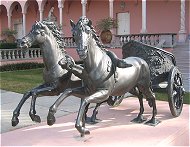ChariotMuseum Label: Chiurazzi description: |
Subject info:
Biga or Votive Chariot. Dedicated to Ceres - bronze (original Roman 1st Century AD) now in
Vatican Museum.
A biga was a lightweight, two horse racing chariot. The original Roman sculpture was
executed in marble in the 1st century A.D.
The horse on the left in the picture was added in the 17th Century.
Ceres, the goddess of grain(s), scattered seeds over the earth while driving her chariot through the skies. Pluto grabbed her daughter and took her into the underworld. Ceres grieves and mourns and nothing grows on earth, Jupiter intervenes and she is allowed to spend part of the year with Ceres (Spring and Summer) and the rest with Pluto underground (Fall and Winter). In the Christian Era the Chariot was used for centuries as an episcopal throne in the church of San Marco, Rome.
